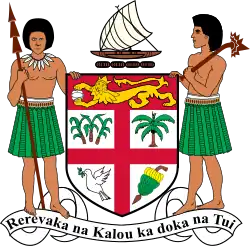1917 Fijian general election
Electoral system
Changes were made to the constitution on 20 July 1916, increasing the number of nominated members in the Legislative Council from 10 to 12; eleven were civil servants and the other had to be a British subject not holding public office.[2][3] The number of elected Europeans remained at seven and the number of appointed Fijians at two. The Governor served as President of the Council.[1]
The Europeans were elected from six constituencies; Eastern, Northern, Southern, Suva, Vanua Levu & Taveuni and Western. Voting was restricted to men aged 21 or over who had been born to European parents (or a European father and was able to read, speak and write English) who were British subjects and had been continuously resident in Fiji for 12 months, either owning at least £20 of freehold or leasehold property or having an annual income of at least £120, and were not on the public payroll.[2]
| Constituency | Geographical area | Election date |
|---|---|---|
| Eastern | Lau Province, Lomaiviti Province | 22 June |
| Northern | Ba District, Colo North Province, Ra Province | 21 July |
| Southern | Colo East Province, Kadavu Province, Naitasiri Province, Namosi Province, Rewa Province (except Suva), Serua Province, Tailevu Province | 23 June |
| Suva | Suva Municipality | 21 July |
| Vanua Levu and Taveuni | Bua Province, Cakaudrove Province, Macuata Province | |
| Western | Colo West Province, Lautoka District, Nadi District, Nadroga Province | 20 July |
Results
| Constituency | Candidate | Votes | % | Notes |
|---|---|---|---|---|
| Eastern | John Maynard Hedstrom | Unopposed | Re-elected | |
| Northern | Frederick Clapcott | 67 | 69.1 | Elected |
| Henry Lamb Kennedy | 30 | 30.9 | Unseated | |
| Informal votes | 3 | – | ||
| Southern | Robert Crompton | Unopposed | Re-elected | |
| Suva | Henry Marks | 187 | 38.2 | Re-elected |
| Henry Milne Scott | 179 | 36.6 | Re-elected | |
| Francis Reimenschneider | 123 | 25.2 | ||
| Informal votes | 2 | – | ||
| Vanua Levu & Taveuni | Joseph MacKay | 78 | 51.0 | Elected |
| T.A. Montgomery | 70 | 45.8 | ||
| James McConnell | 5 | 3.3 | ||
| Informal votes | 3 | – | ||
| Western | Reginald Harricks | 66 | 71.0 | Elected |
| Charles Wimbledon Thomas | 27 | 29.0 | Unseated | |
| Informal votes | 1 | – | ||
| Source: Ali | ||||
Appointed members
The nominated members were appointed on 3 August.[1]
| Position | Member |
|---|---|
| Governor (President) | Ernest Bickham Sweet-Escott |
| Agent-General of Immigration | Robert Malcolm Booth |
| Attorney General | Alfred Karney Young |
| Chief Medical Officer | George Lynch |
| Colonial Postmaster | Herbert Paul St. Julian |
| Colonial Secretary | Eyre Hutson |
| Commissioner of Lands | Dyson Blair |
| Commissioner of Works | William Akerman Miller |
| Receiver General | Richard Sims Donkin Rankine |
| Registrar-General | Roger Green |
| Secretary for Native Affairs | Kenneth Allardyce |
| Superintendent of Agriculture | Charles Henry Knowles |
| Representing Indo-Fijians | Badri Maharaj |
| Fijian member | Joni Madraiwiwi I |
| Fijian member | Joni Antonio Rabici |
| Source: Fiji Blue Book[1] | |
Aftermath
The results of the Vanua Levu and Taveuni seat were later annulled by the Supreme Court. As a result, a by-election was held in November 1917 which Joseph MacKay was again elected,[4] receiving 84 votes to the 50 of J. Harper received 50 votes and three for James McConnell.[5] However, MacKay died on 6 December.[4] John Francis Dyer was subsequently elected in the constituency in another by-election in 1919.[6]
References
- Fiji Blue Book for the Year 1917, p91
- 1917 Legislative Council Election Fiji Elections Archive
- Fiji, The Stationery Office, pxli
- Fiji Royal Gazette 1920, p57
- 1917 Fiji Legislative Council elections Fiji Elections
- Fiji Blue Book for the Year 1919, p89
